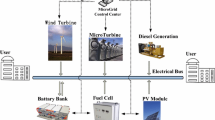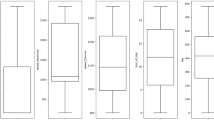Abstract
Recently, the combined economic and emission dispatch (CEED) problem, which aims to simultaneously decrease fuel cost and reduce environmental emissions of power systems, has been a widespread concern. To improve the utilization efficiency of primary energy, combined heat and power (CHP) units are likely to play an important role in the future. The goal of this study is to propose an approach to solve the CEED problems in a CHP system which consists of eight power generators (PGs), two CHP units and one heat only unit. Owing to the existence of power loss in power transmission line and the non-convex feasible region of CHP units, the proposed problem is a nonlinear, multi-constraints, non-convex multi-objectives (MO) optimization problem. To deal with it, a recurrent neural network (RNN) combined with a novel technique is developed. It means that the feasible region is separated into two convex regions by using two binary variables to search for different regions. In the frame of the neurodynamic optimization, existence and convergence of the dynamic model are analyzed. It shows that the convergence solution obtained by RNN is the optimal solution of CEED problem. Numerical simulation results show that the proposed algorithm can generate solutions efficiently.











Similar content being viewed by others
References
Güvenç U, Sönmez Y, Duman S et al (2012) Combined economic and emission dispatch solution using gravitational search algorithm. Sci Iran 19(6):1754–1762
Chen G, Ding X (2015) Optimal economic dispatch with valve loading effect using self-adaptive firefly algorithm. Appl Intell 42(2):276–288
Yang H, Yi J, Zhao J et al (2013) Extreme learning machine based genetic algorithm and its application in power system economic dispatch. Neurocomputing 102:154–162
Abdelaziz AY, Ali ES, Elazim SMA (2016) Combined economic and emission dispatch solution using flower pollination algorithm. Int J Electr Power Energy Syst 80:264–274
Benasla L, Belmadani A, Rahli M (2014) Spiral optimization algorithm for solving combined economic and emission dispatch. Int J Electr Power Energy Syst 62:163–174
Meng A, Mei P, Yin H et al (2015) Crisscross optimization algorithm for solving combined heat and power economic dispatch problem. Energy Convers Manag 105:1303–1317
Liu C, Shahidehpour M, Li Z et al (2009) Component and mode models for the short-term scheduling of combined-cycle units. IEEE Trans Power Syst 24(2):976–990
Sadeghian HR, Ardehali MM (2016) A novel approach for optimal economic dispatch scheduling of integrated combined heat and power systems for maximum economic profit and minimum environmental emissions based on Benders decomposition. Energy 102:10–23
Bahmani-Firouzi B, Farjah E, Seifi A (2013) A new algorithm for combined heat and power dynamic economic dispatch considering valve-point effects. Energy 52:320–332
Song YH, Chou CS, Stonham TJ (1999) Combined heat and power economic dispatch by improved ant colony search algorithm. Electr Power Syst Res 52(2):115–121
Davoodi E, Zare K, Babaei E (2017) A GSO-based algorithm for combined heat and power dispatch problem with modified scrounger and ranger operators. Appl Therm Eng 120:36–48
Ghorbani N (2016) Combined heat and power economic dispatch using exchange market algorithm. Int J Electr Power Energy Syst 82:58–66
Perea E, Ruiz N, Cobelo I et al (2016) A novel optimization algorithm for efficient economic dispatch of combined heat and power devices. Energy Build 111:507–514
Hopfield JJ (1982) Neural networks and physical systems with emergent collective computational abilities. Proc Natl Acad Sci 79(8):2554–2558
Wang J (1994) A deterministic annealing neural network for convex programming. Neural Netw 7(4):629–641
Xia Y, Leung H, Wang J (2002) A projection neural network and its application to constrained optimization problems. IEEE Trans Circ Syst I Fundam Theory Appl 49(4):447–458
Li C, Yu X, Huang T et al (2016) A generalized Hopfield network for nonsmooth constrained convex optimization: Lie derivative approach. IEEE Trans Neural Netw Learn Syst 27(2):308– 321
Schädler K, Wysotzki F (1999) Comparing structures using a Hopfield-style neural network. Appl Intell 11(1):15–30
Liu Q, Wang J (2011) A one-layer recurrent neural network for constrained nonsmooth optimization. IEEE Trans. Syst. Man Cybern. B (Cybernetics) 41(5):1323–1333
He X, Huang T, Yu J et al (2017) An inertial projection neural network for solving variational inequalities. IEEE Trans Cybern 47(3):809–814
Lee H, Kim E, Pedrycz W (2012) A new selective neural network ensemble with negative correlation. Appl Intell 37(4):488–498
He X, Ho D, Huang T, Yu J, Abu-Rub H, Li C, Second-order continuous-time algorithms for economic power dispatch in smart grids. IEEE Trans Syst Man Cybern Syst. https://doi.org/10.1109/TSMC.2017.2672205
Li C, Yu X, Huang T, He X, Distributed optimal consensus over resource allocation network and its application to dynamical economic dispatch. IEEE Trans Neural Netw Learn Syst. https://doi.org/10.1109/TNNLS.2017.2691760
Wang T, He X, Huang T et al (2017) Collective neurodynamic optimization for economic emission dispatch problem considering valve point effect in microgrid. Neural Netw 93(9):126–136
Suman M, Rao MVG, Hanumaiah A et al (2016) Solution of economic load dispatch problem in power system using lambda iteration and back propagation neural network methods. Int J Electr Eng Inf 8(2):347
Yao Y, He X, Huang T et al (2016) A projection neural network for optimal demand response in smart grid environment. Neural Comput Appl 1–9. https://doi.org/10.1007/s00521-016-2532-0
Liu N, Wang C, Yu X et al (2016) PV energy sharing cloud: Towards automatic pricing and energy management. In: IEEE power and energy society general meeting. IEEE, pp 1–9
He X, Huang T, Li C et al (2015) A recurrent neural network for optimal real-time price in smart grid. Neurocomputing 149(PB):608–612
Geem ZW, Cho YH (2012) Handling non-convex heat-power feasible region in combined heat and power economic dispatch. Int J Electr Power Energy Syst 34(1):171–173
Xia Y, Feng G, Wang J (2008) A novel recurrent neural network for solving nonlinear optimization problems with inequality constraints. IEEE Trans Neural Netw 19(8):1340–1353
Mohammadi-Ivatloo B, Moradi-Dalvand M, Rabiee A (2013) Combined heat and power economic dispatch problem solution using particle swarm optimization with time varying acceleration coefficients. Electr Power Syst Res 95:9–18
Bai X, Qiao W, Wei H et al (2015) Bidirectional coordinating dispatch of large-scale V2G in a future smart grid using complementarity optimization. Int J Electr Power Energy Syst 68:269–277
Ummels BC, Gibescu M, Pelgrum E et al (2007) Impacts of wind power on thermal generation unit commitment and dispatch. IEEE Trans Energy Convers 22(1):44–51
Basu M (2011) Bee colony optimization for combined heat and power economic dispatch. Expert Syst Appl 38(11):13527–13531
Piperagkas GS, Anastasiadis AG, Hatziargyriou ND (2011) Stochastic PSO-based heat and power dispatch under environmental constraints incorporating CHP and wind power units. Electr Power Syst Res 81(1):209–218
Bazaraa MS, Sherali HD, Shetty CM (2013) Nonlinear programming: theory and algorithms. Wiley, New York
Kinderlehrer D, Stampcchia G (1980) An introduction to variational inequalities and their applications. Academic, New York
Forsgren A, Gill PE (1998) Primal-dual interior methods for nonconvex nonlinear programming. SIAM J Optim 8(4):1132–1152
Piperagkas GS, Anastasiadis AG, Hatziargyriou ND (2011) Stochastic PSO-based heat and power dispatch under environmental constraints incorporating CHP and wind power units. Electr Power Syst Res 81(1):209–218
Guo T, Henwood MI, Van Ooijen M (1996) An algorithm for combined heat and power economic dispatch. IEEE Trans Power Syst 11(4):1778–1784
Bhattacharya A, Chattopadhyay PK (2010) Application of biogeography-based optimization for solving multi-objective economic emission load dispatch problems. Electr Power Compon Syst 38(3):340–365
Acknowledgements
This work was supported in part by the Natural Science Foundation of China under Grant 61403313, Grant 61773320, in part by the Fundamental Research Funds for the Central Universities under Grant XDJK2016B017, in part by the China Post-Doctoral Science Foundation under Grant 2016M600144.
Author information
Authors and Affiliations
Corresponding author
Appendix
Appendix
The transmission loss formula coefficients of ten-unit system are [41]:
Rights and permissions
About this article
Cite this article
Deng, T., He, X. & Zeng, Z. Recurrent neural network for combined economic and emission dispatch. Appl Intell 48, 2180–2198 (2018). https://doi.org/10.1007/s10489-017-1072-3
Published:
Issue Date:
DOI: https://doi.org/10.1007/s10489-017-1072-3




